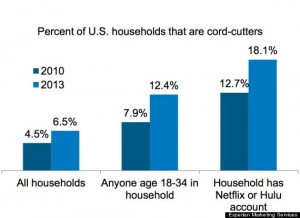By LARISSA FORESE
September 25, 2014
If you haven’t heard of the phenomenon of online streaming, you may have been living under a rock for quite some time.
Netflix has been taking over dorm rooms and households for years, but just recently worked its way over to Europe, expanding its online streaming brand across the globe. Netflix has been drawing in customers in America with it’s binge watching powers, and it is now seeping over the pond and into many European countries.
Netflix, Amazon Prime Instant Video and Hulu Plus are the new competitors for the cable companies all around the world. Netflix however, seems to be the most popular in the online streaming frenzy, especially among American college students. But why stop there? Netflix has already conquered America and is looking to take on most of Europe with it’s on-demand type streaming.
“Netflix is very convenient, I don’t like going to the movie theater so it saves me time and money, ” said I’india Davenport a junior at Ramapo College.
Netflix was created in 1997 by Reed Hastings and Marc Randolph. This site all started from frustration and a great idea that solved a need by movie loving people around the world. The duo created the idea for mail order DVDs while Hastings was forced to pay $40 in fees at a video rental store.
In 1999, is when Netflix became similar to what it is today: sales were dying causing the company to turn into a subscription based service solely for DVDs.
Netflix blew up the online streaming scene in 2007 and has not looked back since. It now has over fifty million members and its services reaches over forty countries around the world, it also just infiltrated countries in Europe such as: France, Germany, Belgium, Austria, Switzerland and Luxembourg, Friday, Sept. 19.
As Netflix popularity grows, cable subscriptions are shrinking and shrinking fast. More people are canceling their cable and living with Netflix subscriptions, according to the Huffington Post.
Cord cutting, as mentioned in a Huffington Post Article, is now known as foregoing the costly cable and satellite bills and watching television shows and movies through online services. The number of “cord cutters” has risen 44 percent in just three years; now 7.6 million homes go without cable or satellite services.

This graph shows the amount of people in the United States who have dropped their cable companies and now stream online.
PHOTO//Experian Marketing Services
Kelly Nelson, from Bricktown, New Jersey, has since moved to Texas and has continued her Netflix subscription but never returned to the cable companies.
“One of the main reasons I switched was because how expensive it is, not having my parents paying for cable showed me how expensive it really can be, Netflix is just so much cheeper,” said Nelson.
According to the Economist, Americans are paying around $80 a month for cable television- not including broadband- when Netflix users are paying $10 a month.
A study done by Experian Marketing Group, also shows a fifth of the United States that does not use cable services has a subscription to Netflix or Hulu, the number rises as the age of users goes down. John Fetto, a senior analysts at Experian Marketing Services told the Huffington Post, does see the decline and feels many in the younger generation may never experience paying for cable or satellite.
“The young millennials who are just getting started on their own may never pay for television,” said Fetto to the Huffington Post. “Pay TV is definitely declining.”
Many college students turn to Netflix than the cable provided by the schools themselves. Binge watching is a new epidemic among the college students; and it is defined by the Oxford Dictionary as watching multiple episodes of a television program in rapid succession, typically by means of DVDs or digital streaming.
With college students having stressed schedules, watching Netflix means watching their favorite shows and movies on their own time. But is there such thing as too much of good thing?
“It’s addicting, once you start a show you can’t stop,” said Doris Ilic, a Ramapo sophomore.
Davenport agrees, Netflix distracts her from her work but she just can’t seem to drag her eyes away from her laptop screen.
“At night I tell myself I’m going to read, but instead I find myself watching Netflix until I fall asleep,” said Davenport. “I get my work done eventually, so I don’t feel it has a huge impact on my grades.”
Netflix not only poses a threat to the school work of college students, but it also takes time away from their social life as well. Ilic feels it is so addicting that she finds herself skipping out on her friends and social activities.
“When I started watching Orange is the New Black I would tell my friends I was busy when they wanted to go out, but I was really just watching Netflix,” said Ilic.
With many of her peers being subscribed to Netflix, she also agrees with Fetto and sees a decline in the relationship between generation and cable services.
“I honestly think eventually cable TV will be gone, and Netflix will be the primary source for shows and movies. Especially with Netflix expanding throughout Europe. It’s unstoppable and unavoidable,” said Ilic.
I thought the article had great content with valid points. All of the points were backed up by studies or voices which made the article complete. The only thing I would comment on is that when you bring up how Netflix is distracting students from their school work and social activities, I feel that could be a whole other story completely…the article focused more on cable subscription declines and Netflix popularity.